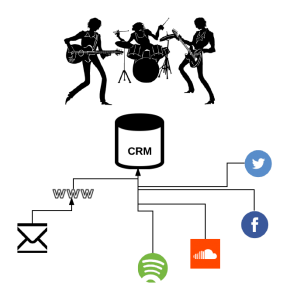Digital Strategy, Digital Transformation, Music, Product Management
Update 16 January 2018: Earlier this week, Facebook confirmed it will be rolling out changes to its news feed algorithm and is going to reduce the weighting that applies to Pages from brands (and bands) and increase the weighting applied to posts from your friends. This is likely to decrease Page engagement significantly, one article is suggesting that it may reduce reach, clicks and engagement by 80%. With that in mind, it’s now even more important to ensure you have your own space for engaging with your fans. Read on for our thoughts on how you can work to develop your own first party fan data.
Any digital marketing agency or digital marketing consultant will tell you that promoting your music online looks very different in 2017 to how it did in the year 2000. Where then, you had your own website, maybe a MySpace page (remember those?!) and had fans subscribe to a mailing list that actually sent cards through the post, now, it’s a little bit different.
Fast forward, and it’s likely that where you now interact most with your fans is through Twitter, Facebook or some other social media platform. These platforms are great, and you should continue to engage with fans there, but they come with their own set of risks.
Any digital marketing agency or digital marketing consultant will tell you that promoting your music online looks very different in 2017 to how it did in the year 2000. Where then, you had your own website, maybe a MySpace page (remember those?!) and had fans subscribe to a mailing list that actually sent cards through the post, now, it’s a little bit different.
Fast forward, and it’s likely that where you now interact most with your fans is through Twitter, Facebook or some other social media platform. These platforms are great, and you should continue to engage with fans there, but they come with their own set of risks.
Running the relationship with your fans through a 3rd party like Snapchat, YouTube or Twitter may seem like a good idea because you don’t have to worry about running the technology and they are ubiquitous platforms that most of the world is connected through, but you shouldn’t rely on them in isolation.
Here’s why…
Using that 3rd party tool means that Facebook or Twitter (or Tumblr or whichever social network you are connecting through) are the ones who have all the control. They hold all the playing cards and all the leverage and they can make changes at any time and for any reason with no warning. They are the ones who ‘own’ the customer data and they use that to make money from advertisers. But what if they decided to make money from people who host brand Pages or accounts (like the ones that you setup for your artists) as well?
Just recently we’ve seen an example of how this might play out in a test that was run in Sri Lanka, Bolivia, Slovakia, Serbia, Guatemala, and Cambodia. Facebook made a change to their platform in these countries, separating out the posts in the news feed that come from brand Pages and moving them into a separate feed entirely. This didn’t bode well for those pages as they saw interactions on their posts fall significantly.
There was speculation that Facebook planned to make the owners of the pages pay for the privilege of then getting back into the main news feed. The company has said they currently have no plans to do this en mass but that doesn’t stop them from making changes in future that impact whether your fans see your content.
So what’s the solution?
So what’s the solution?
Diversify. Continue to talk with your fans through those platforms but simultaneously develop your own 1st party fan data.
Development of 1st party data is one of the main things concerning marketers from all industries at the moment – almost 3/4 of marketers surveyed have said that 1st party data provides the greatest insight into their customers and of those, 81% say they use 1st party data to get greater return on investment (ROI) from their customers.
Just what is 1st party data?
1st party data is information that you collect yourself from your fans. It typically would sit somewhere within your own technology stack, sometimes using a Customer Relationship Management (CRM) tool. You can get pretty fancy with how you maintain and collect it, but essentially it boils down to being information that you collect and you own. Since you are collecting it yourself, direct from your fans, it is deemed to be the most accurate set of data.
You can do this via your own website, a property that you control and can update on your own terms. This allows you direct access to your fans, where you own the data and don’t have to rely on 3rd party platforms for feedback on what they think of your new music. Once you own that relationship, what you do with it and how you communicate with them is up to you (within the realms of the law of course).
Development of 1st party data is one of the main things concerning marketers from all industries at the moment – almost 3/4 of marketers surveyed have said that 1st party data provides the greatest insight into their customers and of those, 81% say they use 1st party data to get greater return on investment (ROI) from their customers.
Just what is 1st party data?
1st party data is information that you collect yourself from your fans. It typically would sit somewhere within your own technology stack, sometimes using a Customer Relationship Management (CRM) tool. You can get pretty fancy with how you maintain and collect it, but essentially it boils down to being information that you collect and you own. Since you are collecting it yourself, direct from your fans, it is deemed to be the most accurate set of data.
You can do this via your own website, a property that you control and can update on your own terms. This allows you direct access to your fans, where you own the data and don’t have to rely on 3rd party platforms for feedback on what they think of your new music. Once you own that relationship, what you do with it and how you communicate with them is up to you (within the realms of the law of course).
In this way, you can continue to communicate with your fans via social networks but are also secure in the knowledge that if one day those platforms make a change that removes your ability to talk with your fans, you have an alternative means of engaging with them. It’s the technological equivalent of not putting all your eggs in one basket.
The diagram below shows how you can collect your own 1st party data, collect 3rd party data from the social platforms you are already using, and generate a bigger picture of who your fans are and how you should communicate with them. For example, you may have a fan who likes you on Facebook, has signed up to your email newsletter but you can see has yet to purchase tickets to your next gig (using email address as the common identifier). This then would allow you to send an email to this person that is more effective than sending a blank “ticket sale” reminder email to your entire database.

As a clever person once said, knowledge is power and the more you can talk to your fans, the more you know, and the better your relationship with them will be. So don’t be beholden to Facebook news feed changes and find yourself an alternative means of communicating with your fans.
Main photo credit: Photo by Jesse Darland on Unsplash
The diagram below shows how you can collect your own 1st party data, collect 3rd party data from the social platforms you are already using, and generate a bigger picture of who your fans are and how you should communicate with them. For example, you may have a fan who likes you on Facebook, has signed up to your email newsletter but you can see has yet to purchase tickets to your next gig (using email address as the common identifier). This then would allow you to send an email to this person that is more effective than sending a blank “ticket sale” reminder email to your entire database.

As a clever person once said, knowledge is power and the more you can talk to your fans, the more you know, and the better your relationship with them will be. So don’t be beholden to Facebook news feed changes and find yourself an alternative means of communicating with your fans.
Main photo credit: Photo by Jesse Darland on Unsplash
0
